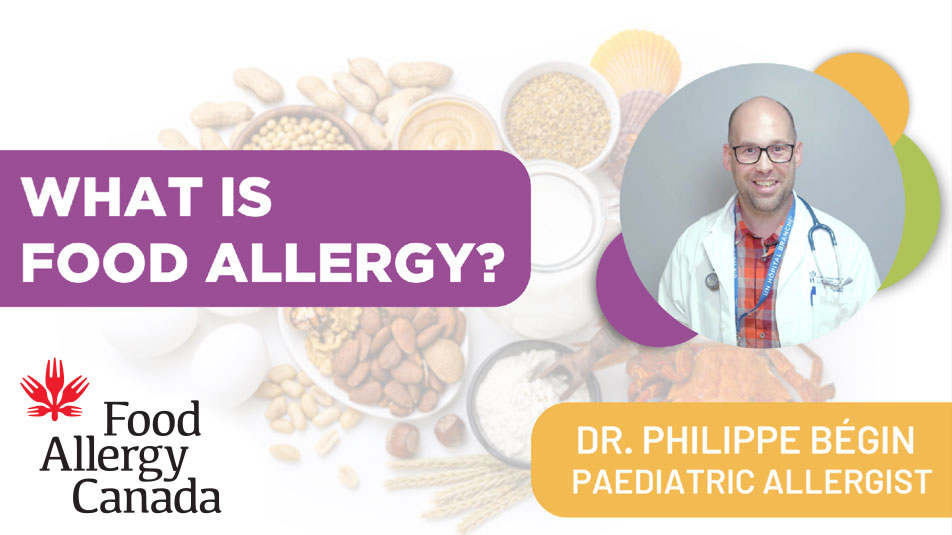Food allergy defined
A food allergy occurs when the body’s immune system sees a certain food as harmful and reacts by triggering an allergic reaction.
There are two categories of food allergy:
- Immunoglobulin E (IgE) mediated – this is where symptoms result from the body’s immune system making antibodies called IgE. This type of food allergy can trigger anaphylaxis, life-threatening allergic reactions. Most of our content on this site relates to IgE mediated food allergy.
- Non-IgE mediated – this is where other parts of the body’s immune system react, causing symptoms, but does not involve the IgE antibody. Many non-IgE reactions are believed to be T-cell mediated.
You can have both IgE mediated food allergy and non-IgE mediated food allergy.
IgE mediated food allergy: causes severe allergic reactions that can be life-threatening
When you have this type of food allergy, you have an IgE-mediated immune response to a protein in a food. Even eating a very small amount of the food or particles of the food can potentially trigger a life-threatening allergic reaction (anaphylaxis).
- Your immune system normally protects you from germs and disease. It helps you to fight off bacteria, viruses, and other tiny organisms that can make you sick.
- If you have a food allergy, your immune system mistakenly treats something in a particular food (most often, the protein) as if it’s dangerous to you.
- Your body reacts to the food (an allergen) by having an allergic reaction.
- Learn the basic science behind food allergy with our webinar with Dr. Manel Jordana. He focuses on the research for allergy prevention, allergy therapies, and what could potentially lead to a cure. There is also a question period at the end of the presentation.
Watch the webinar
 Oral Allergy Syndrome (OAS)/Pollen Food Syndrome (PFAS)
Oral Allergy Syndrome (OAS)/Pollen Food Syndrome (PFAS)With OAS or PFAS, the proteins in certain fresh fruits, vegetables and tree nuts are similar to those in pollens and can cause allergic symptoms.
Non-IgE mediated food allergy
Most symptoms of non-IgE mediated food allergies involve the gastrointestinal/digestive tract. Symptoms may include vomiting and diarrhea, but are not life-threatening. Symptoms can take longer to develop and may last longer than IgE mediated allergy symptoms.
When an allergic reaction occurs with this type of allergy, epinephrine is usually not needed. In general, the best way to treat these allergies is to stay away from the food that causes the reaction. Examples of non-IgE mediated food allergies are below.
 Eosinophilic Esophagitis (EoE)
Eosinophilic Esophagitis (EoE)EoE is a swallowing disorder that affects the esophagus, the tube that leads from the throat to the stomach.
 Food Protein-Induced Enterocolitis Syndrome (FPIES)
Food Protein-Induced Enterocolitis Syndrome (FPIES)FPIES is an inflammation involving both the small intestine and the large intestine (colon).
Please note, the content below relates to IgE-mediated food allergy.
How food allergy is diagnosed
- People with food allergy are diagnosed by an allergist and prescribed an epinephrine auto-injector (e.g. EpiPen, ALLERJECT) in case of a severe allergic reaction (anaphylaxis), as even a very small amount of the food they are allergic to can trigger a potentially life-threatening reaction.
- Nobody knows yet what causes people to have food allergy, and there is no known cure.
- Download our handy 1 page info sheet on diagnosis
- Download
- Watch our videos on “What is food allergy” and “What is anaphylaxis”
- Video “What is food allergy” with Dr. Philippe Bégin
- Video “What is anaphylaxis” with Dr. Philippe Bégin
Risk factors for developing food allergy
The risk factors for food allergy include:
- Age: Food allergy is more common in young children than in older children or adults.
- Family history: You’re more likely to have a food allergy if your parent or sibling has one.
- Another food allergy: If you have a food allergy, you’re at greater risk for developing another.
- Related medical conditions: Your risk is increased if you have an allergic disease such as asthma, eczema, or hay fever.
Find out how to prevent food allergy from developing with the early introduction of allergens to babies.
Priority food allergens: the most common causes of food allergy
You can be allergic to any food, but some allergies are more common than others. Health Canada lists certain foods as “priority food allergens”, as these foods are associated with 90% of allergic reactions in Canada. Health Canada has established specific labelling requirements for priority food allergens.
Sulphites (a food additive), which do not cause true allergic reactions, are generally grouped with the priority allergens because sulphite-sensitive individuals may react to sulphites with allergy-like symptoms.
Learn about Canada’s priority food allergens, including information on how to avoid the allergens, what the common names are, how they are labelled on food products, examples of where the allergen is found, possible sources of the allergen, and how to report a reaction. You will also find quick facts as well as how to recognize an allergic reaction.
Learn more about sulphites, including possible sources of sulphites, other names for sulphites, non-food sources, and how you can be allergy aware and avoid sulphites.
Non-food allergens
Severe allergic reactions (anaphylaxis) can also be caused by medication, insect stings, latex, exercise, or unknown reasons (“idiopathic”).
Learn more about getting anaphylaxis from non-food allergens, such as medication, insect stings, latex, exercise, or unknown reasons. You’ll learn about each non-food allergen and what you can do to stay safe.


